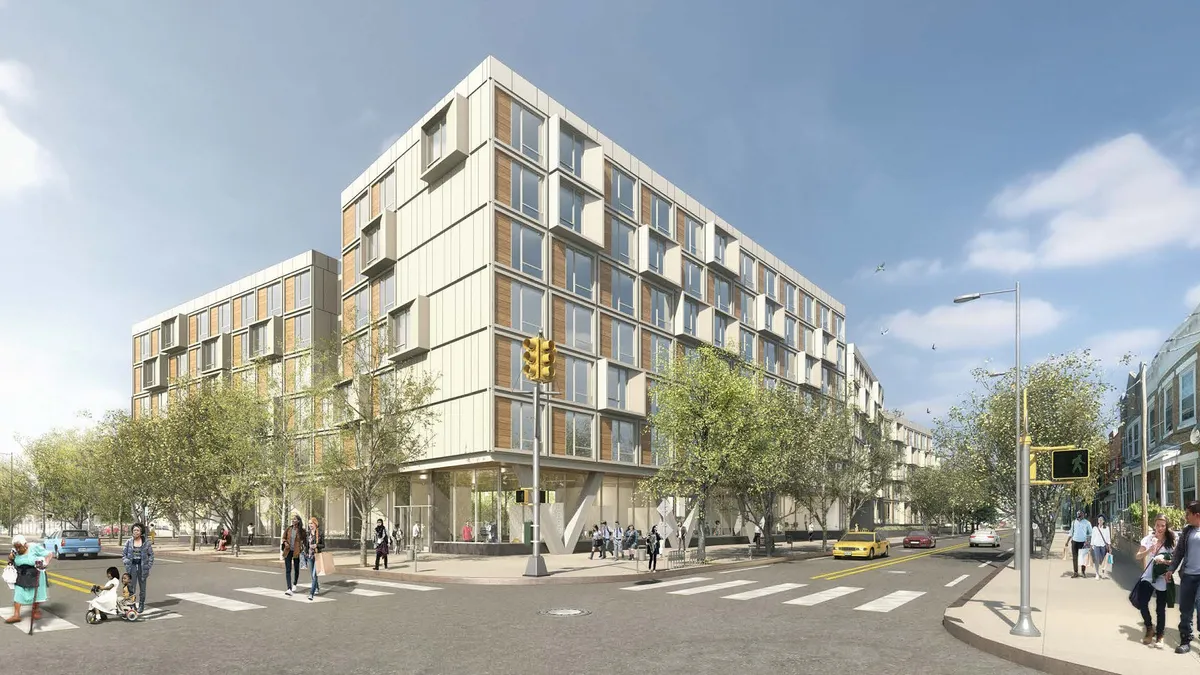Construction's rate of increasing efficiency from one year to the next sits at the bottom of the charts, averaging just 1% annually over the past two decades compared with 2.8% for the total economy, McKinsey & Co. found. The manufacturing sector, meanwhile, grew by 3.6% and could be a perfect role model to the construction industry as it continues to be presented with new, innovative technologies as well as mounting industry challenges.
Prefabrication and modular construction bring some of the process into a controlled industrial environment, not unlike an auto manufacturing plant, where high-quality products can be replicated with little margin of error. In addition to eliminating some of the labor needs and safety risks of jobsites, such production can take place on a rapid schedule while disrupting the classic compartmentation of construction, whereby architects, engineers and contractors work from their own "data islands."
The following recent announcements demonstrate the progress that's being made in the realm of "constructuring," as increasingly complex projects and ambitious schedules demand a rethinking of the building process.
Prescient brings ‘digital thread’ to seismic housing
Prescient announced Tuesday that its proprietary “digital thread” technology, which integrates planning and design with manufacturing and installation, is being used for the largest student housing development underway in the U.S.
The University of California, Davis, complex broke ground last week and is marked by its seismic resiliency, according to a Prescient press release. The structural system “is cost competitive with wood and significantly less expensive than concrete or other steel structures,” said Executive Chairman Satyen Patel.
Prescient, which has completed 36 buildings since its 2012 launch, uses advanced manufacturing technologies such as robotics, laser-cutting systems and numerically controlled (automated) machines. Its proprietary software automatically generates BIM models that become the basis for design and construction. The integrated, data-driven workflow results in a very small margin of error, the company says, comparable to that of the automotive industry.
As it expands beyond the U.S. market, Prescient is targeting earthquake-prone areas in Mexico, Japan, Latin America, India and the Middle East, according to the release.
Modular a top choice for New York’s much-needed affordable housing
Brooklyn, New York-based manufacturer FullStack Modular was tapped for a 167-unit, 100% affordable housing and mixed-use development in Brooklyn’s East New York section, according to a Monday announcement from the New York City Department of Housing Preservation and Development (HPD).
The project (pictured above) includes a mix of studios, one-, two-, three- and four-bedroom homes geared toward low-income and formerly homeless residents. Designed by Think! Architecture and Design, the building will include a green roof, a community plaza and a medical clinic.
FullStack Modular says the selected construction method allows for improved efficiency and cost predictability throughout the course of the project. This and other innovative techniques will be needed to deliver affordable housing at the fast pace needed to meet Mayor Bill de Blasio’s ambitious goal of financing the creation or preservation of more than 300,000 affordable units by 2026, officials say.
New guidelines help modular builders stick to code
Builders and designers are increasingly exploring modular routes to meet housing demand and simplify various aspects of the construction process, and one innovative solution that is trending is converting used shipping containers into housing or other types of building units.
The Modular Building Institute (MBI) last week announced that it led development of an International Code Council (ICC) guideline on the Safe Use of Modified ISO Shipping Containers as Buildings or Building Components, intended to help the AEC industry understand how to modify the structures in compliance with building codes.
MBI also collaborated with the American Institute of Architects (AIA) in developing best practices for modular designers, which highlights both advantages and challenges to the method. Viewing modular as a promising solution to affordable housing and disaster relief demands, the group is working to break down barriers to modular construction, such as state-level regulatory constraints, according to a press release.
“There is such an overwhelming need for facilities of all types that modular construction must play a bigger role in filling the gap,” said MBI Government Affairs Director Jon Hannah. “The high demand, coupled with skilled labor shortages, drives more owners to our industry, and the regulations need to keep up with current construction practices."




















